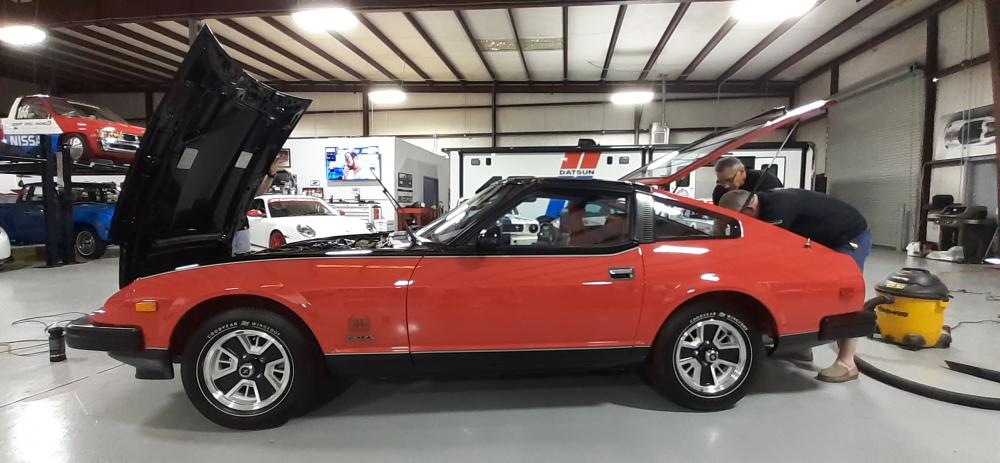Everything posted by SteveJ
-
Parts Wanted: Fair price paid for 240z parts I need
I'll pass your name/number to Randy.
-
Parts Wanted: Fair price paid for 240z parts I need
Darn it. I just sold a Bridgestone spare to Randy Jaffe a couple of months ago.
-
Any smog tips?
One more thing, a fuel pressure gauge could be helpful. Put it between the fuel filter and fuel rail. If your CO is high or NOx is high, you'll need to know your fuel pressure. It could be off spec.
-
Any smog tips?
Adjust your valves. Check your compression to make sure you don't have a weak cylinder. Ask and pay for a pretest. That way if you do not pass, it does not count against you. Then you can adjust and try another pretest. After you pass the pretest, do the regular test. If you fail the pretest, post your results. Excess HC - You aren't burning your fuel. (Ignition/timing/compression) High CO - You are running rich. High NOx - You are running lean.
-
Battery Frame Bolt - Found it!
Having spent plenty of time in the High Desert in the past, I'm impressed with 0.03 in June. Meanwhile I run a portacool in my garage to dehumidify it enough that I don't suffer heat stroke here.
-
cleaning seats
You might want to post photos so we can see what they look like.
-
Battery Frame Bolt - Found it!
But it's a dry heat...
-
260Z factory AC to none AC 280Z
Too bad you already pulled the trigger. Nostalgic AC has a compressor with a bracket for the L series engine, and they will adapt the Z control panel to work with their controls.
-
Retro Belt Seat belts 240z
That is the original anchor point. You might consider adding a small spacer (1/4 inch or so) to aid in clearing the panel.
-
BRE stamped N47
Yeah, Randy also doubts it refers to Brock Racing Enterprises, but he might email the photo to Peter anyway.
-
BRE stamped N47
I would doubt that BRE on that block would have anything to do with Brock Racing Enterprises. Pete disbanded BRE in 72 when he decided to get into hang gliding. The N42 block came out in the 280Z. However, to cover my bases, I did send the picture to Randy Jaffe. Considering how much of a BRE fanatic he is, he may be able to shed some light onto that.
-
260Z factory AC to none AC 280Z
Just a couple of words of warning, there are several components that you will need to find suitable substitutes for, such as the drier and condenser. Even if you could find a stock condenser, you'll probably be running R134A, and the stock condenser is suboptimal for that refrigerant. Also, I tried to see if I could find a way to bench test the expansion valve at the evaporator. There doesn't seem to be such a method. If the expansion valve is bad, you'll end up tearing the system apart and trying to figure out what you could do for a replacement. That's the risk of used AC systems.
-
LED H4 Bulbs on Sale
I have installed a set of these bulbs in a 280ZX. The nice thing about them is that they do NOT require relays. Just pair them with some nice H4 housings, and they will work fine. On the 280ZX, we used Hella housings. I had to modify the rubber seal a little, but they worked out nicely. They are on sale at Amazon as a lightning deal for the next few hours for $40. https://www.amazon.com/AUXITO-Headlight-Bulbs-000LM-6500K/dp/B07TQLK6SH
-
1974 260z question about the key
Originally, it was only 1 key for ignition and door/hatch/glove box locks. However, many ignitions were worn because of the weight of the keychains, and the keys would slide in and out. I replaced my ignition switch a long time ago, so I have two keys.
-
Just taking a look around
Yes, that was mine, and thank you. It's easier to make good videos when you have good subject matter. Look through my channel to see videos from ZCON 2018 and ZCON 2020, too. https://www.youtube.com/channel/UCXsvj3EGiok2_deomAZErHg/videos As for the owner of the shop, Larry Chen of Hoonigan Autofocus did some videos of a few of Randy's cars. https://www.youtube.com/c/HooniganAutoFocus/videos
-
ZCON 2021 Roll Call
While I won't be there, I recently got to spend time with a car that will be in the hotel lobby. Break out your leisure suit, lace up your boogie shoes, and step into the time machine to relive 1980.
-
Z Proto: The next z reveal
I believe August 17 to be exact...Take note ZCON 2021 attendees.
-
Help find long lost 240z
Heck, I didn't need to do much of a search to find him. 😉 It is *ahem* interesting to go through his feed. By the way, the marriage didn't last...
-
ZCON Prep
-
ZCON 2021 Roll Call
I'm out. I'm hoping 2022 will be closer to me.
-
1980 280ZX 10 anniversary car, red black
You are limited tire-wise by keeping the Iron Cross wheels. With it being a black/red 10AE, I suggest keeping the stock wheels. There were only 500 made, and the original wheels will help with maintaining the value. Having said that, the Radial T/As are about as good as you'll find. You can find Dunlop Direzzas in 14 inch but only 185/60. Using a tire size comparison website, that's about 8% smaller than stock on diameter. It might not look right in the wheel wells, and I would hesitate to drive on them in any other conditions than warm (or hot) and dry. The Falken Azenis RT660 might work better than the Dunlops, but with the same constraints on weather. It will still be a little small for the wheel wells.
-
Just taking a look around
LOL, @siteunseenhas it right. I was shooting video at Randy Jaffe's shop today.
- Just taking a look around
Important Information
By using this site, you agree to our Privacy Policy and Guidelines. We have placed cookies on your device to help make this website better. You can adjust your cookie settings, otherwise we'll assume you're okay to continue.













